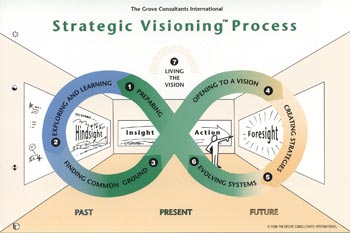 Leadership is a dying art in the world today. The great leaders of the past are found few-and-far between these days. There are some that have been fairly successful that have rose to an iconic status, but have they been truly great leaders or just really successful at running something?
Leadership is a dying art in the world today. The great leaders of the past are found few-and-far between these days. There are some that have been fairly successful that have rose to an iconic status, but have they been truly great leaders or just really successful at running something?
Often there is contention between the skills that a leader needs and what a manager needs. I believe, if you’re not a good leader, you won’t be a good manager, and if you’re not a good manager, you won’t be a good leader. It is my contention that those who apply both of these talents expertly demonstrate what I call, “LeadermentSM.” This is the expert combination of Leadership and Management together.
LeadermentSM | Leadership Begins and Ends With You
In my opinion, self efficacy and locus of control are the two most important concepts anyone can learn and improve upon. Leader and managers, especially, need to focus on this. This is why I talk about this in Leading Yourself.
Both self efficacy and locus of control are measurable psychological aspects of a person. In other words, everyone has self efficacy and locus of control, but the manner in which it manifests itself determines the leader.
Let’s examine each of these and discuss.
Self Efficacy. The extent or strength of one’s belief in one’s own ability to complete tasks and reach goals. Self-efficacy affects every action we take; it strongly influences both the power a we have to face challenges competently and make the choices we need to make.
Self efficacy is measured from a low to high scale based on your belief in your own abilities. Assessment tools general provide back your self efficacy based on several questions rating aspects of yourself from a strongly disagree to a strongly agree.
Those with a low self efficacy have a developed fear of risk. They see themselves as being unable to be successful and as a result, they are often unwilling to take risks or try new things because they are convinced that they will fail. In line with this fear of risk is their fear of uncertainty. A low self efficacy creates a level of self-doubt and uncertainty, which prevent someone from trying things without a guarantee of success. As a result of these two fears, someone with low self efficacy often approach new and difficult tasks half-heartedly are less likely to experience success–thus they are more likely to see themselves as a failure (proving themselves right). Consider to my blog on LeadermentSM last week regarding the Power of Positive Thinking.
Those with a high self efficacy are more self confident in their ability to be successful as a task. They approach tasks or situations with a sense of their ability to be successful. This self-confidence tends to lead to more experience, which further increases their ability, which leads to greater self-confidence. Individuals with a high self-efficacy tend to be able to accurately evaluate their performance and are neither overly-critical nor overly positive but able to examine themselves realistically in order to pursue self-improvement. Of course they have a willingness to take risks because they understand that taking calculated risks increases the chances of success and they are not fearful of failure or mistakes. Generally, those with high self-efficacy feel a sense of accomplishment when they complete something because they believe in themselves and that their ability made it happen.
The main way to increase your self-efficacy is through practice and experience. It’s derived from doing the thing that people with a low self efficacy dread–taking risks. However, success when taking risks, even small risks, can lead to a positive cycle.
Locus of Control. The extent to which individuals believe that they can control events that affect them.
Locus of control is measured from an external to internal on a low to high scale. Individuals with a high internal locus of control believe that events in their life derive primarily from their own actions, whereas people with a high external locus of control would tend to praise or blame an external factor.
Like self efficacy, you can find several assessment tools to measure your own locus of control.
The person with a high external locus of control is obviously the opposite of the one who has a high internal locus of control. This person believes that the whole world is plotting against him, that luck exists, and that life is unfair. The main reason that person believes in luck is to explain how are there people around him succeeding while he can’t. The person who has external locus of control always blames other factors for his failures such as god’s will, bad economy, or lack of luck.
High internal locus of control is a personal trait that every successful person has. People who have a high internal locus of control feel responsible for the outcomes they realize in their lives. They would never say something like, “I failed because it was hard,” but instead they take responsibility by asking themselves, “What was the wrong with what I did,” and, “How can I prevent that from happening the next time?”
In order to build a better internal locus of control, the first thing you have to do is realize that you always have choice to change your situation, even if you don’t like the choices available at the moment. When you are faced with a decision, make a list of all possible courses of action. You can build this list yourself or work with others to help you. When you have a list, evaluate each course of action and decide on the best course of action for you. Don’t lose the list as you might have to go back to it later. Repeat this practice with every decision and you begin to expand your mind to new possibilities by doing this quicker and mentally.
Leadership begins and ends with you. Possessing a high self efficacy and high internal locus of control make great leaders. Not believing in yourself to take risk and believing everything is based on luck and out of your control will lead you to repeated failure. Assess your inner being and then work to improve the areas you need to focus on.
Now when you think of great leaders think about what styles and concepts of LeadermentSM they employed. What did they do that was so effective…that propelled the masses under them to great things. As we can see, these styles vary in application, but an effective leader and manager should understand and apply all traits in a combined approach as appropriate.
LeadermentSM and YouniversitySM are service marks of Crosscutter Enterprises

 Leadership is a dying art in the world today. The great leaders of the past are found few-and-far between these days. There are some that have been fairly successful that have rose to an iconic status, but have they been truly great leaders or just really successful at running something?
Leadership is a dying art in the world today. The great leaders of the past are found few-and-far between these days. There are some that have been fairly successful that have rose to an iconic status, but have they been truly great leaders or just really successful at running something?


 Leadership is a dying art in the world today. The great leaders of the past are found few-and-far between these days. There are some that have been fairly successful leaders that have rose to an iconic status, but have they been truly great leaders or just really successful at running something?
Leadership is a dying art in the world today. The great leaders of the past are found few-and-far between these days. There are some that have been fairly successful leaders that have rose to an iconic status, but have they been truly great leaders or just really successful at running something?

 Leadership is a dying art in the world today. The great leaders of the past, George Washington, Winston Churchill, Alexander the Great, Martin Luther King, even Adolph Hitler, are found few-and-far between these days. There are some that have been fairly successful, like Steve Jobs for instance, that have rose to an iconic status, but have they been truly great leaders or just really successful at running something?
Leadership is a dying art in the world today. The great leaders of the past, George Washington, Winston Churchill, Alexander the Great, Martin Luther King, even Adolph Hitler, are found few-and-far between these days. There are some that have been fairly successful, like Steve Jobs for instance, that have rose to an iconic status, but have they been truly great leaders or just really successful at running something? Start with a Strategic Mindset.
Start with a Strategic Mindset. Harness the Power of Positive Thinking.
Harness the Power of Positive Thinking. Establishing Key Interpersonal Skills.
Establishing Key Interpersonal Skills. Developing a Personal Business Focus.
Developing a Personal Business Focus. Your Health and the Leader Within You.
Your Health and the Leader Within You. Volunteerism — The Personal Training Ground for Personal Development.
Volunteerism — The Personal Training Ground for Personal Development.